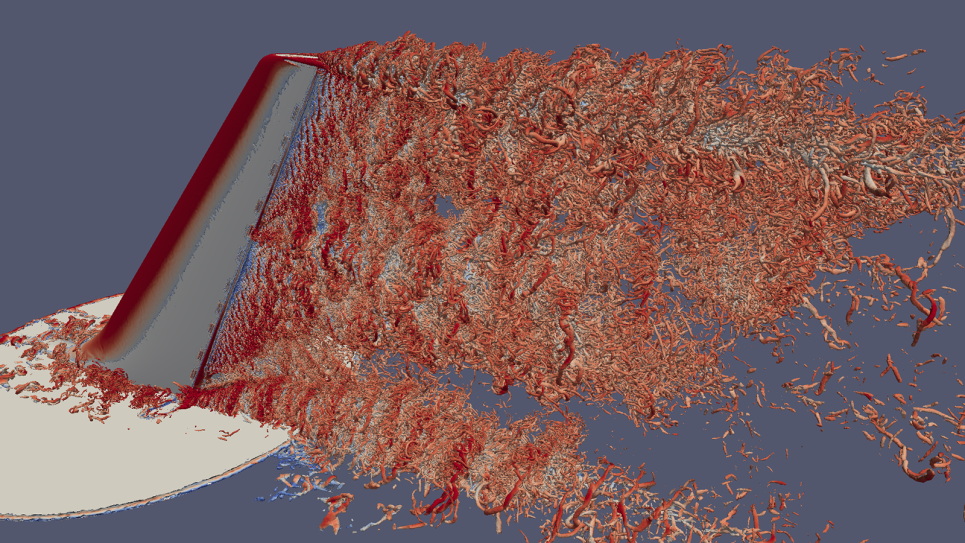Simulations performed using supercomputers at the U.S. Department of Energy’s (DOE) Argonne National Laboratory are providing new insights into the complex physics of airflow that could help improve the performance of supersonic and hypersonic aircraft.
High-speed air flows, such as those experienced by supersonic aircraft, create a thin boundary layer along a solid surface. If the boundary layer is hit by a supersonic shockwave, as forms when a plane approaches supersonic speeds and pushes on the surrounding air, the flow may separate from the surface. If the flow separates from the surface, the performance degrades significantly.
To take one example, the Lockheed SR-71 is designed so that at supersonic speeds, incoming airflow over its engine spike creates shockwaves that are repeatedly reflected between the spike body and the interior of the engine inlet. This slows the airflow into the intake and raises the pressure before fuel is injected, thereby enabling the generation of thrust. If, however, the shock/boundary-layer interaction (SBLI) causes significant flow separation, the performance of the engine will be degraded. In severe cases, it could result in engine flameout.
With the aim of elucidating how SBLI are affected by crossflow (that is, flow along the shock and in a direction parallel to the wingspan), a team of researchers leveraged supercomputing resources at the Argonne Leadership Computing Facility to perform direct numerical simulations (DNS) of skewed SBLI with crossflow so as to approximate the off-design operating conditions that can ultimately cause engine performance degradation and flameout. The ALCF is a DOE Office of Science user facility located at Argonne National Laboratory.
The ultimate goal of the team’s research is to develop a predictive theory for SBLI physics and apply it so as to devise improved modeling techniques for surfaces in large-eddy simulations (LES). LES, as mathematical models for turbulence, are used in a broad range of applications throughout different fields of engineering.
The team, led by University of Maryland mechanical engineer Johan Larsson, published their results in Theoretical and Computational Fluid Dynamics and the AIAA Journal. Their papers demonstrate that the size of a turbulent flow’s separation bubble grows almost 50 percent larger in the presence of crossflow than in cases without crossflow.
The SBLI simulations were carried out on the ALCF’s Theta supercomputer using the code Hybrid, a solver for the compressible Navier-Stokes equations that govern much of fluid dynamics (a compressible flow is one whose density varies).
“In addition to showing that—keeping all other things equal—adding crossflow will yield a separation bubble almost 50 percent larger than without, our simulations captured the skew of the flow,” Larsson said. “Because of this, our results were able to show that crossflow gives many different flow angles across the separation bubble’s boundary layer.”
The team expects their findings to help construct improved models that better predict the size of separation bubbles and account for the effect of crossflow.
“Models able to account for the effects of crossflow would carry important ramifications for a range of applications, including turbomachinery and swept-wing flows, engine inlets and nozzles, and control surfaces,” Larsson explained.
The team’s work is also significant in how it differs from other research in the fields. Historically, most studies of turbulent boundary layers focus on a specific canonical case: the case of incompressible flow, with constant density and viscosity, passing over rigid walls. This research, in contrast, examines the case of compressible flows non-uniform density and viscosity across their boundary layers.
The team was awarded ALCF computing time and resources through DOE’s INCITE program.
==========
The Argonne Leadership Computing Facility provides supercomputing capabilities to the scientific and engineering community to advance fundamental discovery and understanding in a broad range of disciplines. Supported by the U.S. Department of Energy’s (DOE’s) Office of Science, Advanced Scientific Computing Research (ASCR) program, the ALCF is one of two DOE Leadership Computing Facilities in the nation dedicated to open science.
Argonne National Laboratory seeks solutions to pressing national problems in science and technology. The nation's first national laboratory, Argonne conducts leading-edge basic and applied scientific research in virtually every scientific discipline. Argonne researchers work closely with researchers from hundreds of companies, universities, and federal, state and municipal agencies to help them solve their specific problems, advance America's scientific leadership and prepare the nation for a better future. With employees from more than 60 nations, Argonne is managed by UChicago Argonne, LLC for the U.S. Department of Energy's Office of Science.
The U.S. Department of Energy's Office of Science is the single largest supporter of basic research in the physical sciences in the United States and is working to address some of the most pressing challenges of our time. For more information, visit https://energy.gov/science



